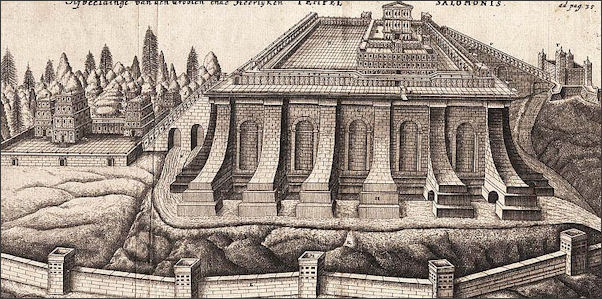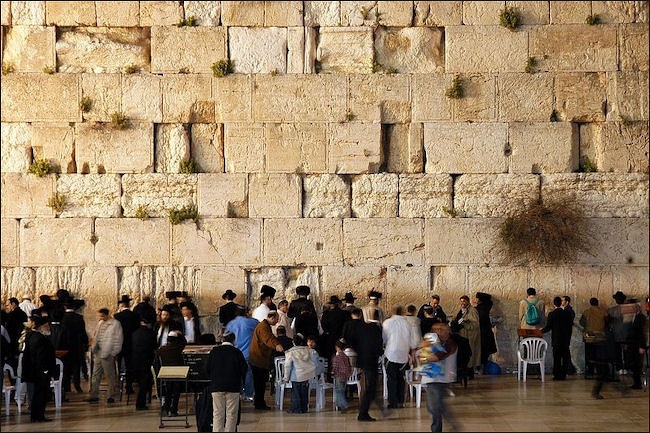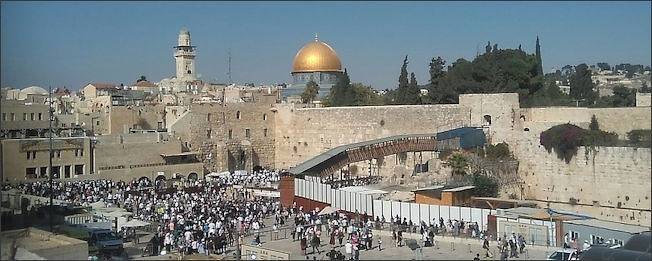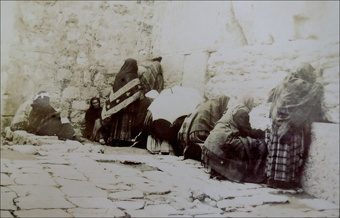Home | Category: Rabbis, Synagogues and Prayers
WESTERN WALL (WAILING WALL)
Western Wall (or Wailing Wall) is Judaism's most sacred site. Essentially an open air synagogue, it is all that is left of the legendary Temple, a massive structure built for the Jews, ironically, not by a Jewish leader but by Roman leader King Herod, one of the most hated men in Palestine, and the man who reportedly ordered the slaughter of every male child under two in his attempt kill the "King of the Jews” (Jesus).
The Western Wall is a retaining wall of a huge platform on which Herod's temple was built in 20 B.C. It is about 18 meters (60 feet) high, five meters (16 feet) thick and composed of large blocks of stone (the largest of which are 9 meters (30 feet) long and weigh 50 tons) and is believed to have supported an esplanade. A 20 foot upper extension of the wall, made of smaller stones, is part of the ramparts of the Temple Mount, which belongs to the Muslims. The Little Wall is an extension of the Western Wall in the Muslim Quarter that draws some boisterously chanting Orthodox Jews much to the displeasure of Muslims who live and work there.
Some Jews argue the Western Wall is not the holiest site in Judaism—the Temple Mount is. Muslims prohibit Jews from worshiping there. Some Jews would like to tear down the Muslim shrines on the Temple Mount and excavate the remains of Herod’s temple underneath. Jews believe that when the true Messiah arrives this temple will be rebuilt.
The name "Wailing Wall" describes the outpouring of emotion manifested by Jews at the wall over the loss the Temple and the 3000 year struggle of their people. A good time to visit the Wall is at night when it is illuminated with floodlights. In the summer of 2002, water oozing from a stone in the wall generated considerable excitement among ultra-Orthodox Jews who viewed the water as tears and regarded it as a possible sign that the true Messiah was coming.
Websites and Resources: Virtual Jewish Library jewishvirtuallibrary.org/index ; Judaism101 jewfaq.org ; torah.org torah.org ; Chabad,org chabad.org/library/bible ; BBC - Religion: Judaism bbc.co.uk/religion/religions/judaism ; Encyclopædia Britannica, britannica.com/topic/Judaism; Yivo Institute of Jewish Research yivoinstitute.org ; Internet Jewish History Sourcebook sourcebooks.fordham.edu ; Aish.com aish.com ; Jewish Museum London jewishmuseum.org.uk ; Jewish History: Jewish History Timeline jewishhistory.org.il/history Jewish History Resource Center dinur.org ; Center for Jewish History cjh.org ; Jewish History.org jewishhistory.org
RECOMMENDED BOOKS:
“Western Wall” by Michael Ronnen Safdie Amazon.com ;
“The Western Wall Tunnels: Touching The Stones of Our Heritage.” by Dan Bahat Amazon.com ;
“Herod's Temple: A Useful Guide To The Structure And Ruins Of The Second Temple In Jerusalem” by Michael Lustig Amazon.com ;
“An Introduction to Second Temple Judaism: History and Religion of the Jews in the Time of Nehemiah, the Maccabees, Hillel, and Jesus” by Lester L. Grabbe Amazon.com ;
“Understanding Second Temple and Rabbinic Judaism” by Lawrence H. Schiffman , Jon Bloomberg, et al. Amazon.com ;
“The Origins of Judaism: An Archaeological-Historical Reappraisal” by Yonatan Adler Amazon.com ;
“Early Judaism: A Comprehensive Overview” by John J. Collins and Daniel C. Harlow Amazon.com ;
“Jews In The Roman World” by Michael Grant Amazon.com ;
“The Jews among the Greeks and Romans: A Diasporan Sourcebook”
by Professor Margaret Williams Amazon.com ;
“Between the Testaments: Pharisees, Sadducees and Essenes” by Robert C. Jones Amazon.com ;
“The Jewish War” by Flavius Josephus , Betty Radice, et al. (Penguin Classics) Amazon.com ;
“The Story of the Jews” Volume One: Finding the Words 1000 BC-1492 AD by Simon Schama (Author) Amazon.com ;
“A History of the Jews” by Paul Johnson, Amazon.com
Western Wall Plaza
Western Wall Plaza sits in front of the Western Wall. Tourists and Jewish faithful from all over the world to gather to pray, read sacred texts, chant, socialize, celebrate, mourn and observe. Men and women pray in separate sections. It is recommended to visit the plaza at different times, especially around the time the Sabbath begins on Friday night,
Many Jews wear white-and-black striped prayer shawls and bob their heads as they pray. Women drape the shawls over their heads. Men wear of the shoulders like ponchos and wear skull caps on their head. Non-Jews are required to dress modestly (men must don a kippa, a paper skull cap, which are available near the wall).
Jews have traditionally stuck wadded up pieces of paper, inscribed with prayers, messages, wishes or names of family who perished in the holocaust, into the cracks of the wall. During major holidays sometimes lines of people form, waiting their turn to pray and leave a message.
The Western Wall is open 24 hours a day, seven days a week. Large crowds gather here on the Sabbath and during Jewish holidays. On Monday and Thursday mornings families gather for Bar Mitzvahs and Bat Mitzvahs. In the area between the Western Wall and the Dung Gate is a huge show of Israeli security including heavily-armed police and soldiers. Visitors entering the area have to pass through security checks, with bags checks and metal detectors. At the Western Wall entrance of the tunnel is a large room where Jews gather to pray and read sacred texts.. On the left side of the Western Wall Plaza is a controversial tunnel.
Solomon’s Temple (The First Temple)

One take on Solomon's Temple
The first Jewish temple was built on Mt. Moriah on the present-day Temple Mount in the 10th century B.C. by Solomon around a stone altar to thank the Lord for leading the Jews to the Promised Land. The stone altar, which is called the Foundation Stone, is where Jews believe God collected dust to make Adam, Abel was killed by Cain, and Abraham almost sacrificed Isaac.
"Behold, I purpose to build a house unto the name of the Lord my God," King Solomon declared. The Temple itself was believed to be the center of the universe, the holiest place in the world, the destination of prayers, and the place where God lived. It’s focal point was the Holy of Holies, a central sanctuary that only the high priest could enter once a year on the Day of Atonement.
The Holy of Holies contained important treasure including, it is said, the Ark of the Covenant. The Ark of the Covenant is a wood-and-gold chest that housed the tablets on which the Ten Commandments were written. The Ark had been built by Moses and recaptured from the Philistines by David.
Solomon’s Temple was built on Mt. Moriah on on a “threshing floor” on the mountain purchased by David for 50 shekels of silver from the Araunah the Jebusite in 1000 B.C. The temple was designed by Hiram, a Phoenician architect, who is believed to have modeled it after the Ball Melqart in Tyre, which Heredotus said has one pile of "gold, the other of emerald." Solomon’s people were nomads and shepherds and they lacked experience building monuments, which is why he sought the assistance of his ally Hiram.
Dedicated to Jehovah, the temple took seven years to build and required hundred sof workmen and laborers to complete. According to the Bible’s Book of Kings temple was comprised of a series of courtyards, each one more holy than the one outside it, with holy sanctuary with the Ark in the middle. The main building was made from cut stone and Lebanon cedar timber, and was veiled in purple cloth and overlaid with gold. The doors were gilded olive wood. The entrance was marked by two great pillars of bronze.
Solomon paid for the building with wheat and olive oil, 20 cities in Galilee and 120 tenants of gold. Next to the temple, Solomon built a great palace. According to the Old Testament 22,000 oxen and 120,000 sheep were sacrificed at the dedication of temple. So much money was spent on the temple that it drained money from the treasury which presumably could have been used to beef up the military and keep the kingdom from splitting apart.
Solomon's Temple was partly destroyed and the Ark of the Covenant was lost when Nebuchadnezzar and the Babylonians sacked Jerusalem in 586 B.C. In a Babylonian chronicle Nebuchadnezzar boasted theat he “captured the city and...took heavy tributes and brought it back to Babylon.” The Bible has a similar account except that the “tributes” are referred to as “all the treasures of the Temple and the royal palace.” The fate of the Ark is not known. According to one legend it was stolen by the illegitimate son of Solomon and Sheba and taken to Ethiopia and placed in a church in Aksum, where only a guardian monk has access to it. A modest Second Temple was built in 539 B.C.
Archeological Evidence of Solomon's Temple
There is no direct archeological evidence of the existence of Solomon's reign. But in 1997, archaeologists discovered a 13-word scrap of Old Hebrew script on an inscription that mentioned the payment of three shekels of silver to King Solomon's Temple in Jerusalem. Dated between the 7th and 9th centuries, its is the oldest non-Biblical reference to Solomon's temple ever recorded. The inscription was found on a pottery fragment in a private collection and its source is not known. A shekel was a measure of weight equal to around 11 grams.
In January 2003, the existence a legal-pad-size stone tablet with inscription on running the Jewish Temple was revealed. Dated to the 9th century B.C. and called the Jehoash tablet or Yoash stone, it was heralded as “the most significant archeological find in Jerusalem and in the land of Israel.” The tablet was inscribed with ancient Hebrew letters and named after a king who ruled Judea from 835 to 796 B.C. and listed repairs needed at the temple and how a person named Jehoash planned to pay for them. Later it was determined that the Yoash stone was a fake based on word usage and the way the letters were inscribed and the composition of the patina.
One of the most important pieces to Jews in the Israel Museum is an insignificant-looking ivory pomegranate bearing an ancient Hebrew inscription. It is described as the only relic ever recovered from King Solomon's treasures. The thumb-sized piece, thought to have topped a scepter carried by a Temple priest, bears the inscription "Belonging to the Temple of the Lord, holy to the priests." It dates from the mid-8th century B.C., the time of Solomon's Temple.
The ivory pomegranate and a stone tablet with inscriptions on how to maintain the Temple were later reveled to be a fake. See Jesus’ brother James, Christianity.
Digging is forbidden at the site of Solomon’s Temple out of fear it would cause tensions to rise between Jews and Muslim. In 1986, archeologist discovered a eighth-century B.C. gate in Jerusalem that may have led to Solomon's Temple.
Herod’s Temple (The Second Temple):
Herod built a great temple on the site of Solomon’s Temple to win over his Jewish subjects. He replaced the modest 6th century B.C. temple with a temple complex that covered a staggering 35 acres. Because tradition forbid the construction of a temple larger than Solomon’s temples most of the complex was a platform—described by Josephus as “the greatest ever heard of”—made of debris from a loped off mountain and held up with a retaining wall with stones, some of which were 30 feet long and weighed 50 tons.
Some 18,000 workers were hired to build the Temple. Mammoth stones were used to make the walls and foundations; cedar beams and great marble columns supported the roof. Around the central building were 13 gates through which only Jews could enter. The most famous of these, the bronze Nicanor Gate, was so heavy it required 20 men to open. The opening of this gate signaled the beginning of the day.
Temple Buildings
It is not known exactly what the Temple looked like. No drawings of it exist, and no thorough archeological excavations at the site of the temple have been done. It is believed that the Temple was not a single building but a series of precincts and courtyards, one inside the other, with a sanctuary with important religious objects at the center. Some have speculated that this sanctuary was enclosed by a monumental 80-foot-high tower. Jews were required to pay half a silver shekel a year in “temple tax.”
Outside the sanctuary was the Court of the Priests, where the priests performed animal sacrifices and other rituals on a massive altar. This in turn was surrounded by the Court of the Israelites, where Jewish men gathered to pray and were able to see the animal sacrifices in the Court of Priests. Outside of the Court of Israelites was the Court of Women, where women could pray, and outside of that was the Court of Gentiles, which was open to everyone. Gentiles were strictly forbidden from entering the sacred Jewish areas. A sign was found in the Temple area that was written in Greek read: any non-Jew who entered “is answerable himself for his ensuing death.”

Medieval view of Solomon's Temple
Life at the Temple
During the pilgrimage season tens of thousands of thousands of visitors visited the Temple. Around the entrance were baths for ritual purification, small shops and vendors who sold animals for sacrifices. The moneychangers outside the Temple, whose tables were overturned by Jesus, exchanged the foreign currency of pilgrims for local silver shekels.
Some historians have speculated that this area was like Speakers Corner in London, a place where crazies and wannabe Messiahs could stand on the equivalent of a soap box and rant and rave. The pilgrims often camped out in the hills around the temple. Festivals were regarded as festive occasions and no doubt people partied and sang and drank heavily. Money spent by pilgrims, believers and visitors supported a large economy.
Rituals and animal sacrifices at the Temple were performed by priestly class that purified themselves with ashes of a red heifer. The high preist was a descendant of Moses’ brother Aaron. Jewish men, Jewish women and Gentiles were all allow to enter the Temple but each group was segregated to a specific area. Roman soldiers had a post set up to maintain order.
The historian Paul Johnson wrote: “The place was as vast as small city. There were literally thousands of priests, attendants, temple soldiers and minions. Dignity was quite lost amide the smoke of the pyres, the bellows of terrified beasts, the sluices of blood, the abattoir stench, the unconcealed and unconcealable machinery of tribal religion.”
Jesus and the Destruction of the Temple
Jesus addressed his disciples at the Temple when it was still under construction and overturned the tables of the moneychangers nearby and predicted the temple would fall. Jesus is believed to have been outraged that moneychangers that were allowed on the Temple grounds.
In A.D. 70 Jesus’s prediction came true when Titus, later the Emperor of Rome, burned the great temple to punish rebellious Jewish zealots. Religious objects were carried off and the Temple was replaced with a pagan shrine. All that remained of the Temple were its four retaining walls. The Emperor Hadrian (reigned A.D. 117-138) rebuilt Jerusalem under the new name Aelia Capitolina in A.D 136 and erected a statue of Jupiter on the site of the Temple According to Jewish prophecies the Temple will be rebuilt when their Messiah comes. Some Jews are already preparing for this.
To see what the temple may have looked like check out the 1/20 scale marble and stone model at the Holy Land Hotel. According to this reconstruction the temple had a medieval-style and several boxy, domed and columned towers. Just off of Jaffa Road, on a side street with the Russian church, the Church of the Holy Trinity, and the police station, is pillar meant to be placed on the Royal Portico of Herod’s Temple. It was cracked as is was quarried and has been left here for 2000 years, today, surrounded by weeds and trash
Western Wall After the Destruction of Herod’s Temple:
Byzantine Christians destroyed the pagan shrine in 629 and used the area as a garbage dump to show their contemp of the Jews. Arab conquerors cleaned up the site and built the Dome of the Rock and other Muslim shrines. When the Crusaders took over they used as stables for their animals, an act considered sacrilegious by the Muslims.
In the 16th century, the Ottoman Sultan Suleyman the Magnifiscent permitted the Jews to make the Western Wall their official holy place and had the famous architect Sunan to build an oratory for them there.
Archeologist working below the Wailing wall have the foundations of 8th century Muslim palaces and Roman streets.
When the Jordanian Arabs controlled the Old City and East Jerusalem from 1948 to 1967, Jews had no rights at the Western Wall or the Temple mount.

Western Wall
Tunnel from the Western Wall
A tunnel from the Western Wall (reached via a gateway at the northern edge of the Western Wall plaza) runs for 488 meters (534 yards) and links the Western Wall with the Via Dolorosa. Discovered in 1987, it was built in the 2nd century along a natural water system follows the western foundation of the Temple Mount and an ancient Roman roadway. It was at ground level when King Herod’s Temple was razed by the Romans in the A.D. 1st century and since has been covered by construction materil and debris.
The secret tunnel was discovered when Muslim worshipers noticed that water had seeped mysteriously out of a well. Orthodox Jews excavated tunnel on the edge of the Temple Mount, near the Dome of the Rock, Islam's third holiest site, presumable to find the Ark of the Covenant, the Jew's most scared object which hasn't been seen for 2000 years. The Ark of the Covenant, the most scared Jewish object; the equivalent of the True Cross or the Holy Grail to Christians.
Tourists are allowed to walk through the tunnel with a guide. In the past there was a three-month waiting list to get into the tunnels, but during the troubles in the early 2000s it was possible to enter without waiting. Visitor can walk through the tunnel its entire length.
The tunnel is dark and less than a meter wide in places. It opens to large subterranean vaults, passes 570-ton stones, aqueducts, ancient roads and cisterns, and displays of artifacts from the Hasmonean, Herodian, Roman, Mamluk and Crusader periods, Along they way they pass sex-segregated praying groups and a computerized model of the Temple Mounts that shows how the important Muslim shrines have been placed on top of Jewish ones,
The tunnel was nearly finished for years but was not completed out of fear of raising the ire of Muslims, whose shrines were above it. It was opened to tourists in that late 1980s but only be entered and exited from the Western Wall.
Western Wall Prayer Notes
Ari Rabinovitch of Reuters wrote:“Millions of people a year visit the Western Wall -- one of Judaism’s holiest sites -- and leave a written prayer on pieces of paper wedged into the cracks of the ancient stones. The tradition has been adopted by members of many faiths around the world. It is very common for Christian pilgrims traveling through the Old City of Jerusalem to stop by the Western Wall and leave a note, the rabbi says. [Source:Ari Rabinovitch, Reuters, September 3, 2007]
“The office of Rabbi Shmuel Rabinowitz, which manages the site, estimates that more than 5 million people visited the Western Wall in 2006. Israel’s Tourism Ministry said that about 1.5 million of them were foreign tourists. At most hours of the day the Western Wall is lined with people deep in prayer. Many lean forward and touch their foreheads to the stones. With eyes closed, they whisper their wishes and kiss the wall when they have finished praying. “The notes are a way to pray if you don’t know how. After all, if you want to receive, you have to ask,” said Rabinowitz from his office in the Old City of Jerusalem...Finding a snug spot in the wall for a note can be a challenge. Yaniv Singer, 28, who led a tour group that visited the Western Wall, had trouble placing his prayer. “It fell out of about three places before I managed to stick it in a crack way up high,” he said.
“Because the notes are never read by those who collect them it is impossible to know the religion of the people who sent them, the rabbi said. “You can ask for anything. You spill your heart and then you leave strengthened,” said Moshe Azolai, 29, who visited the site with relatives from the United States. Azolai left a prayer for his nephew, who was one of several 13-year-old boys being honored in a Bar Mitzvah ceremony in the hot summer sun.
“The tradition of leaving notes started nearly 300 years ago when a rabbi sent his students with a prayer in writing because he was unable to make the journey, Rabinowitz said. A first time visitor from Ukraine, who gave only his first name, Dmitri, said he could “feel” that the area was holy. “I placed a note asking for good health. I believe it will help,” he said. Across a partition in a separate women’s area, a mother, holding her daughter, managed to cram a note into a crack already overflowing with paper. “It’s for a member of my family who couldn’t make it here,” she said.”

Temple Mount and the Western Wall
Where Do the Prayer Notes from the Western Wall Go?
Rabbi Shmuel Rabinowitz is in charge of taking out prayer notes to make room for new ones. Ari Rabinovitch of Reuters wrote: “As Rabbi of the Western Wall, it is up to Rabinowitz to make sure there’s room for future paper wishes. Twice a year his team collects hundreds of thousands of notes and buries them on Jerusalem’s Mount of Olives. [Source: Ari Rabinovitch, Reutersm September 3, 2007]
Rabinowitz and a dozen workers sweep the wall with wooden sticks in order to reach up high to snare the notes closest to the heavens. They never read them and have never counted the number of scripted prayers, but in each collection there are enough to fill about 100 shopping bags, each with thousands of notes, Rabinowitz said. An entire chapter in one of Rabinowitz’s books deals with the issue of discarding the Western Wall notes. “There is an old argument about whether to burn the notes or bury them,” Rabinowitz said. According to Jewish law, it is forbidden to destroy holy texts. Instead, prayer books and scriptures are “reposited” in containers and often buried in Jewish cemeteries.
“But long before notes were stuck in the Western Wall, it was custom for religious Jews to place prayer notes at the graves of rabbis considered holy. Traditionally, these notes are burned. Rabinowitz said burning is a pure way to deal with the notes, but burying them according to Jewish tradition is more honorable. Even with the rabbi’s twice-a-year cleaning -- the next one will take place before the Jewish New Year in mid-September --finding a snug spot in the wall for a note can be a challenge.”
Image Sources: Wikimedia, Commons
Text Sources: Internet Jewish History Sourcebook sourcebooks.fordham.edu; National Geographic, BBC, New York Times, Washington Post, Los Angeles Times, Smithsonian magazine, , Reuters, AP, AFP, Lonely Planet Guides, Compton’s Encyclopedia and various books and other publications.
Last updated February 2024


